
Andrew Fisher was an Australian politician and trade unionist who served as the fifth prime minister of Australia from 1908 to 1909, 1910 to 1913 and 1914 to 1915. He held office as the leader of the Australian Labor Party (ALP), and was particularly notable for leading Labor to its first federal election victory and first majority government.

John Christian Watson was an Australian politician who was the third prime minister of Australia, in office from 27 April to 18 August 1904. He was the inaugural federal leader of the Australian Labor Party (ALP) from 1901 to 1907 and was the first member of the party to serve as prime minister.
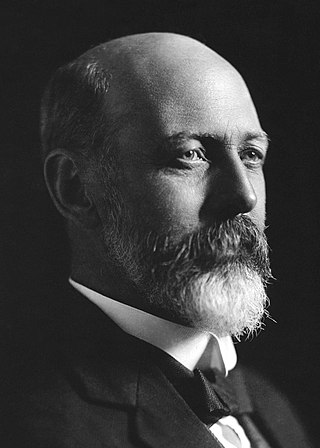
Sir Joseph Cook was an Australian politician who served as the sixth prime minister of Australia, from 1913 to 1914. He held office as the leader of the Liberal Party, having previously been leader of the Anti-Socialist Party from 1908 to 1909. His victory at the 1913 election marked the first time that a centre-right party had won an outright majority at an Australian federal election.
The Protectionist Party, also known as the Protectionist Liberal Party or Liberal Protectionist Party, was an Australian political party, formally organised from 1887 until 1909, with policies centred on protectionism. The party advocated protective tariffs, arguing it would allow Australian industry to grow and provide employment. It had its greatest strength in Victoria and in the rural areas of New South Wales. Its most prominent leaders were Sir Edmund Barton and Alfred Deakin, who were the first and second prime ministers of Australia.
The Liberal Party was a parliamentary party in Australian federal politics between 1909 and 1917. The party was founded under Alfred Deakin's leadership as a merger of the Protectionist Party and Anti-Socialist Party, an event known as the Fusion.

The First Deakin ministry (Protectionist) was the 2nd ministry of the Government of Australia. It was led by the country's 2nd Prime Minister, Alfred Deakin. The First Deakin ministry succeeded the Barton ministry, which dissolved on 24 September 1903 following Sir Edmund Barton's retirement from Parliament to enter the inaugural High Court. The ministry was replaced by the Watson ministry on 27 April 1904 after the Labour Party withdrew their support over the Conciliation and Arbitration Bill.

The Watson ministry (Labour) was the 3rd ministry of the Government of Australia, and the first national Labour government formed in the world. It was led by the country's 3rd Prime Minister, Chris Watson. The Watson ministry succeeded the First Deakin ministry, which dissolved on 27 April 1904 after Labour withdrew their support and Alfred Deakin was forced to resign. The ministry was replaced by the Reid ministry on 17 August 1904 after the Protectionist Party withdrew their support over the Conciliation and Arbitration Bill.

The Reid ministry was the 4th ministry of the Government of Australia. It was led by the country's 4th Prime Minister, George Reid. The Reid ministry succeeded the Watson ministry, which dissolved on 17 August 1904 after the Protectionist Party withdrew their support and Chris Watson was forced to resign. Due to having to rely on the Protectionists to retain office, half of the ministry was forced to accommodate conservative Protectionists - leading to the government to sometimes be referred to as the Reid-McLean Ministry. The ministry was replaced by the Second Deakin ministry on 5 July 1905 after the Protectionists withdrew their support and returned to office with the support of the Labour Party.
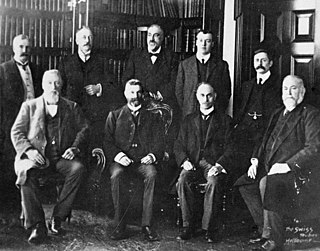
The Second Deakin ministry (Protectionist) was the 5th ministry of the Government of Australia. It was led by the country's 2nd Prime Minister, Alfred Deakin. The second Deakin ministry succeeded the Reid ministry, which dissolved on 5 July 1905 following the resignation of George Reid after the Protectionists withdrew their support and gained support from the Labour Party. The ministry was replaced by the First Fisher ministry on 13 November 1908 after the Labour Party withdrew their support and formed their own minority government.

The Third Deakin ministry (Liberal) was the 7th ministry of the Government of Australia. It was led by the country's 2nd Prime Minister, Alfred Deakin. The Fourth Deakin ministry succeeded the First Fisher ministry, which dissolved on 2 June 1909 after the Protectionist Party and the Anti-Socialist Party merged into the Liberal Party "fusion" and withdrew their support in order to form what became the first majority government in federal Australian history. The ministry was replaced by the Second Fisher ministry on 29 April 1910 following the federal election that took place on 13 April which saw the Labour Party defeat the Liberals.

The Second Hughes ministry was the 12th ministry of the Government of Australia. It was led by the country's 7th Prime Minister, Billy Hughes. The Second Hughes ministry succeeded the First Hughes ministry, which dissolved on 14 November 1916 following the split that took place within the governing Labor Party over the issue of conscription. This led to Hughes and his supporters leaving the party to form the National Labor Party, which swiftly received parliamentary support from Joseph Cook and the Liberal Party. The ministry was replaced by the Third Hughes ministry on 17 February 1917 after National Labor and Commonwealth Liberal merged into the Nationalist Party.
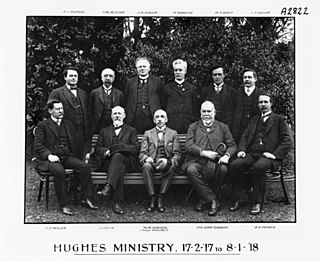
The Third Hughes ministry (Nationalist) was the 13th ministry of the Government of Australia. It was led by the country's 7th Prime Minister, Billy Hughes. The Third Hughes ministry succeeded the Second Hughes ministry, which dissolved on 17 February 1917 after the governing National Labor Party merged with the Liberal Party to form the Nationalist Party. The National Labor Party itself formed as a consequence of the split that took place within the then-governing Labor Party over the issue of conscription. The ministry was replaced by the Fourth Hughes ministry on 8 January 1918 following the resignation of Hughes as Prime Minister after a vote of no-confidence within the Nationalist Party in the wake of a failed second referendum on conscription. However, due to a lack of alternative leaders, Hughes was immediately re-commissioned as Prime Minister by Governor-General Sir Ronald Munro Ferguson.
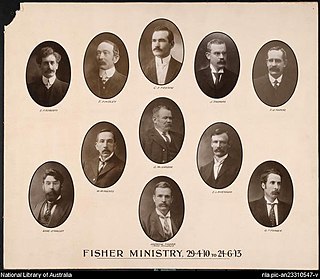
The Second Fisher ministry was the 8th ministry of the Government of Australia. It was led by the country's 5th Prime Minister, Andrew Fisher. The Second Fisher ministry succeeded the Third Deakin ministry, which dissolved on 29 April 1910 following the federal election that took place on 13 April which saw Labor defeat the Alfred Deakin's Liberal Party. It is the first federal government in Australian history to be elected with a majority in the House of Representatives, as well as the first majority national Labor government in the world. The ministry was replaced by the Cook ministry on 24 June 1913 following the federal election that took place in May which saw the Liberals defeat Labor.
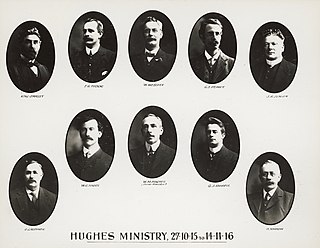
The First Hughes ministry (Labor) was the 11th ministry of the Government of Australia. It was led by the country's 7th Prime Minister, Billy Hughes. The First Hughes ministry succeeded the Third Fisher ministry, which dissolved on 27 October 1915 following Andrew Fisher's retirement from Parliament to become the next High Commissioner to the United Kingdom. The ministry was replaced by the Second Hughes ministry on 14 November 1916 following the split that took place within Labor over the issue of conscription. This led to Hughes and his supporters leaving the party to form the National Labor Party.

Sir William John Lyne KCMG was an Australian politician who served as Premier of New South Wales from 1899 to 1901, and later as a federal cabinet minister under Edmund Barton and Alfred Deakin. He is best known as the subject of the so called "Hopetoun Blunder", unexpectedly being asked to serve as the first Prime Minister of Australia but proving unable to form a government.
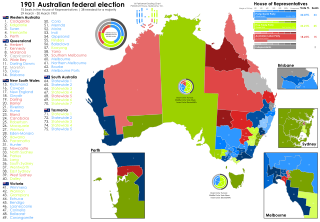
The 1901 Australian federal election for the inaugural Parliament of Australia was held in Australia on Friday 29 March and Saturday 30 March 1901. The elections followed Federation and the establishment of the Commonwealth of Australia on 1 January 1901. All 75 seats in the Australian House of Representatives, six of which were uncontested, as well as all 36 seats in the Australian Senate, were up for election.

The 1906 Australian federal election was held in Australia on 12 December 1906. All 75 seats in the House of Representatives, and 18 of the 36 seats in the Senate were up for election. The incumbent Protectionist Party minority government led by Prime Minister Alfred Deakin retained government, despite winning the fewest House of Representatives votes and seats of the three parties. Parliamentary support was provided by the Labour Party led by Chris Watson, while the Anti-Socialist Party, led by George Reid, remained in opposition.

William Henry Kelly was an Australian politician. He served in the House of Representatives from 1903 to 1919, and served as an honorary minister under Prime Minister Joseph Cook from 1913 to 1914.
The history of the Australian Labor Party has its origins in the Labour parties founded in the 1890s in the Australian colonies prior to federation. Labor tradition ascribes the founding of Queensland Labour to a meeting of striking pastoral workers under a ghost gum tree in Barcaldine, Queensland in 1891. The Balmain, New South Wales branch of the party claims to be the oldest in Australia. Labour as a parliamentary party dates from 1891 in New South Wales and South Australia, 1893 in Queensland, and later in the other colonies.
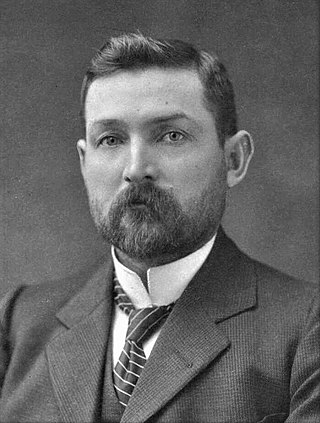
The Watson government was the third federal executive government of the Commonwealth of Australia. It was led by Prime Minister Chris Watson of the Australian Labor Party from 27 April 1904 to 18 August 1904. The Watson government was the first Labor Party national government in both Australia and in the world. Watson was aged just 37 when he became Prime Minister of Australia, and remains the youngest person to have held the post.



























